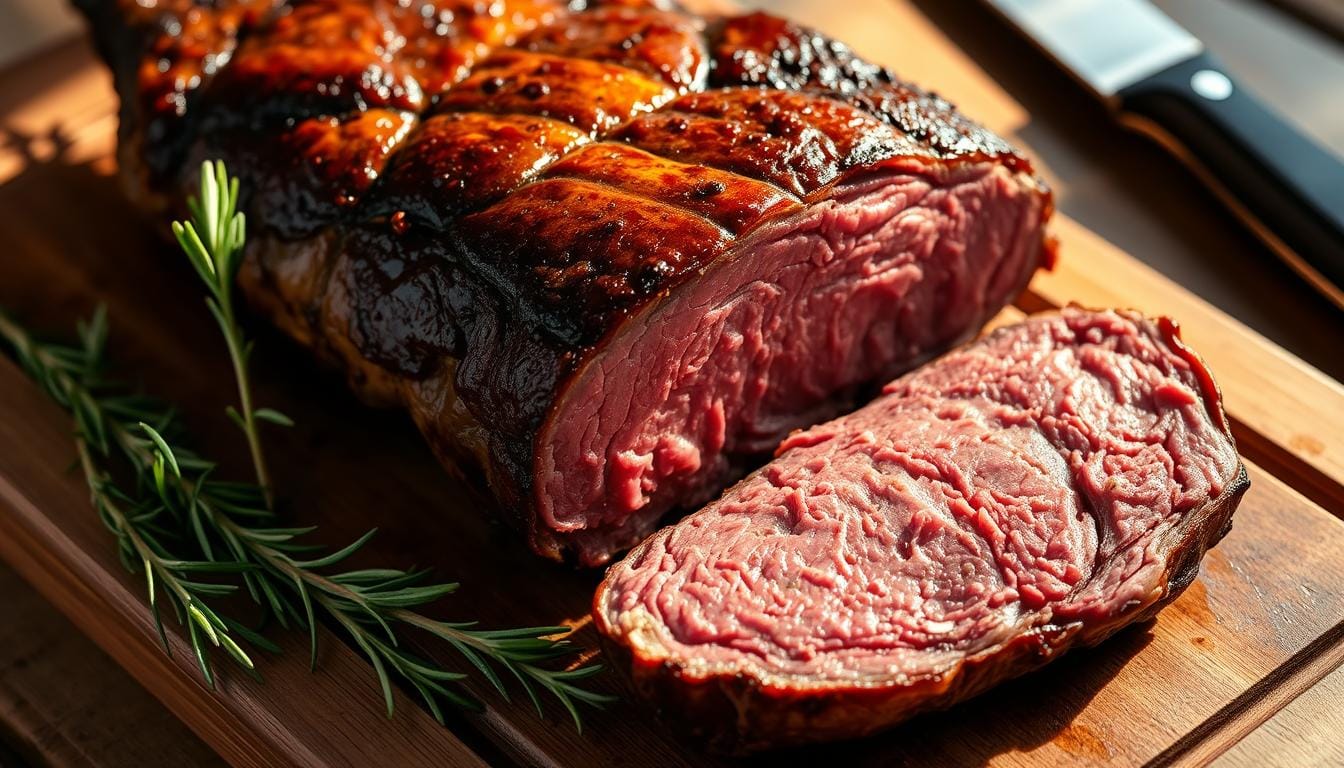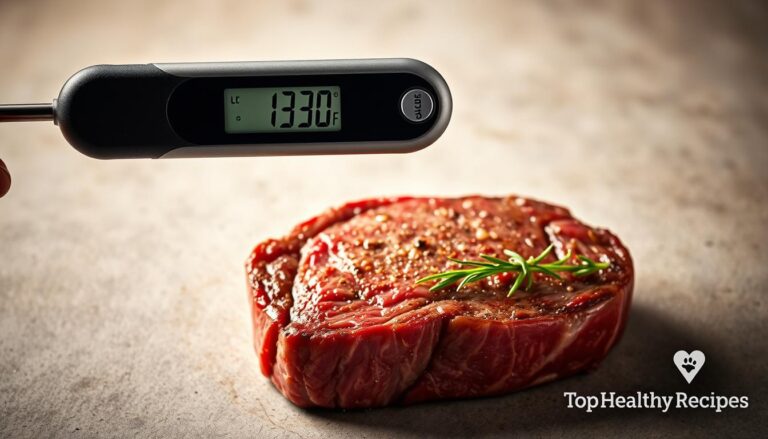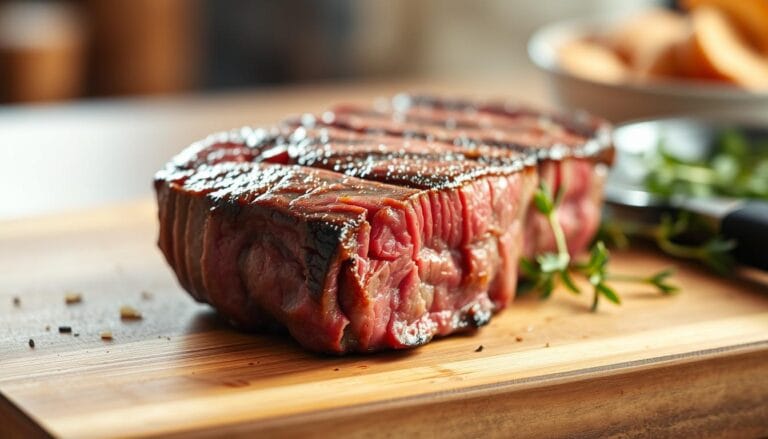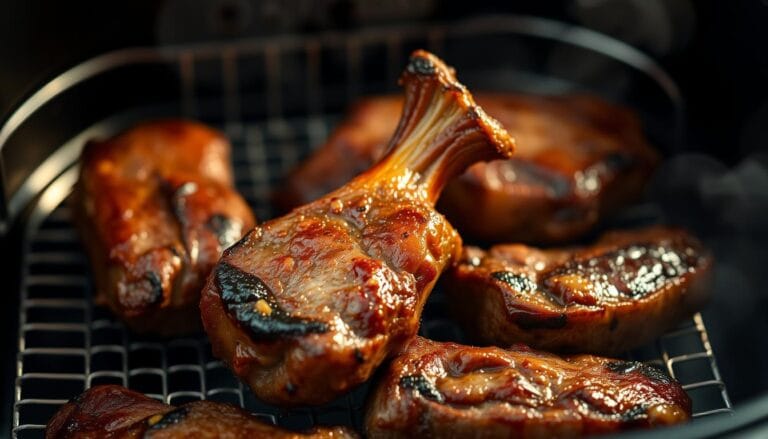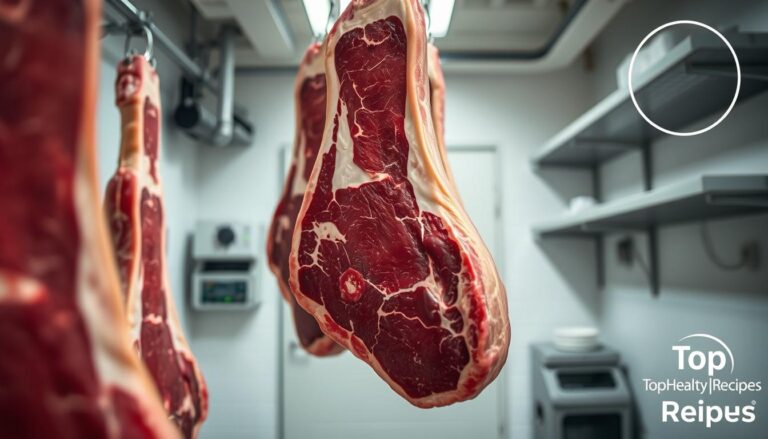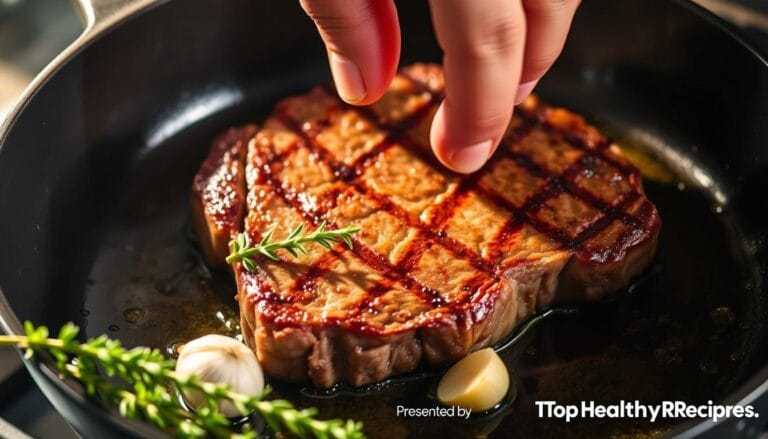Beef Coulotte Roast: the best recipe Tender
Table of Contents
Beef Coulotte Roast: Tender and Juicy
Imagine biting into a tender, juicy roast that’s bursting with flavor. The beef coulotte is a favorite among home cooks and chefs. It’s known for its great taste and value, making it perfect for anyone wanting to improve their cooking.
This article will show you how to pick, prepare, cook, and serve a mouthwatering beef coulotte roast. Whether you’re an experienced chef or just starting out, you’ll learn how to make this meat shine.
Key Takeaways
- Learn how to select the perfect beef coulotte roast for your needs.
- Discover the best techniques for preparing and cooking this cut of beef.
- Understand how to serve a tender, juicy beef coulotte roast with confidence.
- Get tips on how to pair your beef coulotte roast with complementary sides and sauces.
- Elevate your cooking skills and impress your guests with this exceptional dish.
What is a Beef Coulotte Roast?
The beef coulotte roast is a favorite among meat lovers. It’s tender and has a rich beef taste. This cut comes from the top sirloin’s cap and is known for its marbling.
Understanding the Cut
The beef coulotte roast is also called the top sirloin cap or picanha in Brazil. It’s from the upper sirloin part. Butchers trim it to remove extra fat, making it even tenderer.
This cut is celebrated for its fine grain. It’s a perfect mix of lean meat and fat, great for roasting.
Flavor Profile
The beef coulotte roast has a strong beef flavor and is moderately tender. When cooked right, it’s incredibly juicy. The marbling adds moisture and flavor.
The cap of the top sirloin is famous for its rich, beefy taste. The right cooking methods enhance this flavor.
Nutritional Benefits
The beef coulotte roast is packed with protein, vitamins, and minerals. It’s a great source of iron and zinc. These nutrients are key for healthy red blood cells and a strong immune system.
| Nutrient | Amount per Serving | % Daily Value |
|---|---|---|
| Protein | 35g | 70% |
| Fat | 15g | 23% |
| Iron | 3mg | 15% |
| Zinc | 4mg | 25% |
Eating beef coulotte roast can add important nutrients to your diet. It’s a tasty way to enjoy red meat in a healthier manner.
Selecting the Best Coulotte Roast
Finding a great coulotte roast requires looking at a few key things. When you’re at the butcher or grocery store, keep these points in mind. This will help you choose the best one.
Look for Marbling
Marbling is a big deal for a tender and tasty coulotte roast. Marbling is the fat that’s mixed into the meat. It melts when cooked, making the meat juicy and adding flavor. When picking a
Look for fine white flecks in the meat. Too little marbling can make the meat dry. But, too much can make it too fatty.
Consider the Size
The size of your coulotte roast depends on how many you’re serving and if you want leftovers. Coulotte roasts usually range from 2 to 4 pounds. Plan for 6 ounces of meat per person.
For a dinner of 4, a 1.5 to 2-pound roast is perfect. For more people or leftovers, go bigger. For smaller groups, choose a smaller roast.
Organic vs. Conventional
Choosing between organic and conventional beef for your coulotte roast involves several factors. Organic beef is raised without certain chemicals, which some like for health and environmental reasons. But, it’s often pricier and might not taste the same.
- Think about what matters most to you: taste, health, the environment, or cost.
- Organic might be cleaner, but it costs more.
- Conventional beef is cheaper and tastes consistent.
Choosing between organic and conventional coulotte roast is up to you. It depends on what you value most.
Preparing Your Beef Coulotte Roast
Preparing your beef coulotte roast is key to a tender and juicy dish. This involves several important steps. These steps help to enhance the meat’s flavors and textures.
Essential Tools and Equipment
To prepare your beef coulotte roast, you’ll need some essential tools and equipment. These include:
- A sharp knife for trimming excess fat
- A cutting board for preparing the roast
- A meat thermometer to ensure the perfect doneness
- A roasting pan to cook the beef to perfection
- Kitchen twine, if you decide to truss your roast
Having these tools on hand will make the preparation process smoother and more efficient.
Marinating Tips
Marinating your beef coulotte roast can add depth and complexity to its flavor. Here are some tips to keep in mind:
- Marinate for at least 2 hours, but no more than 24 hours
- Use a marinade with a balanced acid-to-oil ratio
- Choose a container that is large enough to hold the roast comfortably
By following these marinating tips, you can enhance the natural flavors of your beef coulotte roast.
Seasoning Choices
The right seasoning can elevate your beef coulotte roast to new heights. Consider the following seasoning options:
- A simple salt and pepper rub for a classic flavor
- A Mediterranean-inspired mix of herbs like thyme and rosemary
- A spicy blend of chili powder and cumin for a Latin American twist
- An Asian-inspired combination of soy sauce, ginger, and garlic
Feel free to experiment with different seasoning combinations to find the one that suits your taste preferences.
Cooking Methods for Coulotte Roast
The coulotte roast can be cooked in many ways, from oven roasting to sous vide. Each method brings out the roast’s rich flavor and tender texture.
Oven Roasting
Oven roasting is a classic method for cooking coulotte roast. It ensures a consistent and evenly cooked result. Start by preheating your oven to 425°F (220°C).
Season the roast with your favorite herbs and spices. For extra flavor, sear the roast in a hot skillet before roasting. Place the roast fat side up in a roasting pan for even browning.
Key steps for oven roasting:
- Roast for 15 minutes per pound, or until the desired internal temperature is reached.
- Use a meat thermometer to check for doneness.
- Let the roast rest for 10-15 minutes before slicing.
Grilling Techniques
Grilling is another great way to cook coulotte roast. It adds a smoky flavor and a nicely charred crust. You can use direct or indirect grilling, depending on your grill and preferences.
Tips for grilling coulotte roast:
- Sear the roast over direct heat for 2-3 minutes per side to achieve grill marks.
- Finish cooking over indirect heat until the desired internal temperature is reached.
- Let the roast rest before slicing to allow the juices to redistribute.
Sous Vide Cooking
Sous vide cooking is a precise method for cooking coulotte roast. It involves sealing the roast in a vacuum bag and cooking it in a water bath at a consistent temperature. For medium-rare, set the water bath to 130°F (54°C), and cook for 1-2 hours.
Benefits of sous vide cooking:
- Ensures a perfectly cooked roast throughout.
- Allows for precise control over the cooking temperature.
- Results in a tender and evenly cooked final product.
After sous vide cooking, sear the roast in a hot skillet to develop a flavorful crust. This finishing step enhances the overall texture and presentation of the dish.
Ideal Cooking Temperatures
The secret to a delicious beef coulotte roast is knowing the right internal temperature. Cooking it to the perfect temperature makes it safe and tasty. It also affects the texture and flavor.
Doneness Levels Explained
It’s important to know the different doneness levels for your beef coulotte roast. The internal temperature tells you how done it is. Here’s a guide to the temperature ranges for each level:
- Rare: 125°F – Warm red center, soft texture.
- Medium-Rare: 135°F – Pink throughout, firmer than rare.
- Medium: 145°F – Slightly pink in the center, moderate firmness.
- Medium-Well: 150°F – A hint of pink, firmer texture.
- Well-Done: 160°F – Fully cooked, no pink color, firm texture.
Remember, the temperature will go up a bit after you take it out of the oven. This is called carryover cooking.
Using a Meat Thermometer
A meat thermometer is key for perfect doneness. You can choose from instant-read digital thermometers or probe thermometers. To get a correct reading, put the thermometer in the thickest part of the roast. Make sure it’s not in fat or bone.
Here are some tips for the best results:
- Choose a thermometer that gives quick and accurate readings.
- Put the thermometer in the thickest part of the roast correctly.
- Take the roast out of the heat when it’s a few degrees below your desired temperature.
By using a meat thermometer and knowing the right temperatures, you can always get your beef coulotte roast just right.
Resting Your Coulotte Roast
To make your coulotte roast tender, let it rest after cooking. This step helps the juices spread evenly. It makes the meat more flavorful and tender.
Importance of Resting
Resting your coulotte roast is key to a great meal. When meat cooks, its fibers tighten and juices move to the surface. Cutting into it right away lets these juices escape, leaving the meat dry.
Resting allows the fibers to relax and juices to spread out. This makes each bite juicy and full of flavor.
The science is simple: cooked meat’s proteins contract. Resting lets these proteins relax, making the meat tender. This is essential for a perfect culotte beef experience.
How Long to Rest
The resting time depends on the roast’s size. For average roasts, 10 to 15 minutes is best. Also, cover the roast loosely with foil to keep it warm without trapping steam.
| Roast Size | Resting Time | Notes |
|---|---|---|
| Small (1-2 lbs) | 5-10 minutes | Keep an eye on it to prevent overcooking |
| Medium (2-3 lbs) | 10-15 minutes | Ideal for most coulotte roasts |
| Large (3+ lbs) | 15-20 minutes | Ensure it’s tented properly to maintain warmth |
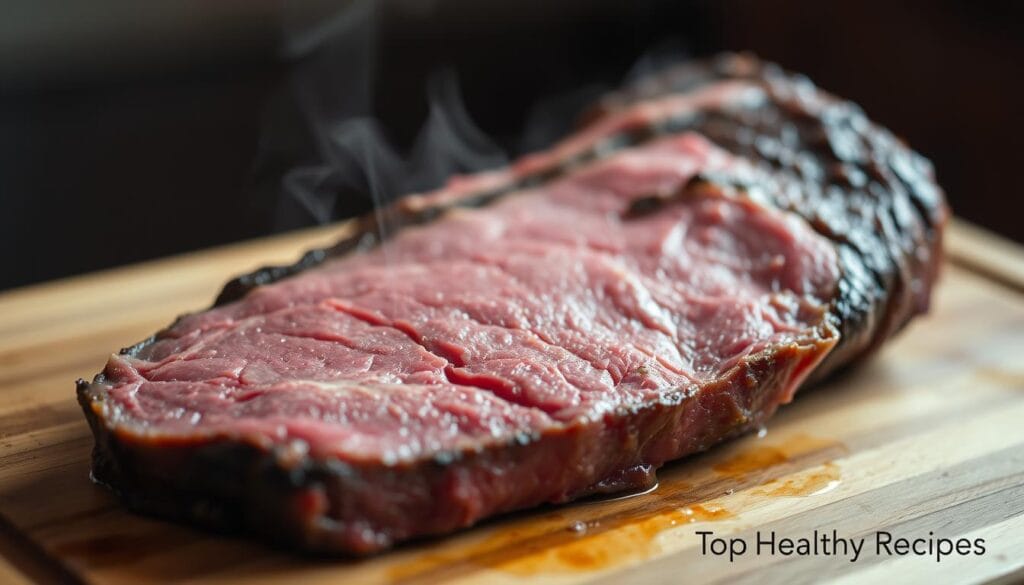
Understanding and using resting correctly can make your culotte beef unforgettable. It ensures a meal that’s both satisfying and memorable.
Serving Suggestions
Now that your coulotte roast is perfectly cooked, it’s time to think about the rest of your meal. The right side dishes and sauces can really make your meal stand out. They’ll add to the rich flavor of the roast, making your dinner unforgettable.
Side Dishes That Pair Well
Choosing the right side dishes is key to a great meal. Here are some ideas, sorted by type:
- Starch Options: Try roasted potatoes, rice pilaf, or crusty bread with your coulotte roast.
- Vegetable Pairings: Roasted asparagus, sautéed mushrooms, or grilled veggies offer a nice contrast to the beef.
- Salad Suggestions: A simple green salad or a hearty grain salad can round out your meal.
| Side Dish | Preparation Time | Flavor Profile |
|---|---|---|
| Roasted Potatoes | 45 minutes | Crunchy outside, fluffy inside |
| Sautéed Mushrooms | 15 minutes | Earthy, savory |
| Grilled Vegetables | 20 minutes | Smoky, slightly charred |
Sauces and Condiments
The perfect sauce or condiment can take your coulotte roast to the next level. Here are some ideas:
- Classic Accompaniments: Au jus, horseradish cream, or chimichurri are great with beef.
- Unexpected Options: Try herb-infused oils or spicy sauces for a unique flavor.
Think about the occasion when you plate your meal. For a family-style meal, slice the roast thinly and serve with your chosen sides. For a fancy presentation, arrange the slices on a platter. Add fresh herbs and serve the sauces on the side.
Storing Leftovers
Storing leftover beef coulotte roast right is key to keeping it fresh and safe. After enjoying your roast, you must store it to stop bacteria from growing. This ensures it stays good for later.
Best Storage Practices
To store your beef coulotte roast right, let it cool down to room temperature in two hours. This step is vital to stop bacteria from growing. Once it’s cooled, put it in an airtight container or wrap it tightly in plastic or foil.
For the fridge, keep the wrapped roast at 40°F (4°C) or below. Your beef coulotte roast can stay fresh in the fridge for 3 to 4 days.
If you want to keep it longer, freeze your beef coulotte roast. Wrap it well in freezer-safe wrap or foil, or use a vacuum sealer. Label it with the date and what’s inside. Frozen beef coulotte roast can last 2 to 3 months.
Reheating Tips
When reheating your beef coulotte roast, do it right to keep it tender and flavorful. For the oven, preheat to 325°F (165°C), wrap it in foil, and heat until it’s hot again.
You can also use a microwave with a steam trick. Cover it with a microwave-safe lid or plastic wrap. Or, use a sous vide machine for precise reheating.
Getting creative with your leftover beef coulotte roast is fun. Slice it for sandwiches, dice it for hash or stir-fries, or add it to soups and salads for extra flavor.
Popular Recipes for Beef Coulotte Roast
Beef coulotte roast is a versatile cut that can be prepared in various delicious ways. Whether you’re looking for a traditional recipe or something with a bit of spice, we’ve got you covered.
Classic Coulotte Roast Recipe
A classic coulotte roast recipe is a great way to let the natural flavors of the beef shine. To start, you’ll need:
- 1 (1.5-2 pound) beef coulotte roast
- 2 tablespoons olive oil
- 1 tablespoon chopped fresh thyme
- 1 tablespoon chopped fresh rosemary
- 2 cloves garlic, minced
- Salt and pepper, to taste
Preheat your oven to 400°F (200°C). Rub the coulotte roast with olive oil, then season with thyme, rosemary, garlic, salt, and pepper. Place the roast in a roasting pan and roast for about 20-25 minutes per pound, or until it reaches your desired level of doneness. Let it rest for 10-15 minutes before slicing and serving.
Spicy Marinade Variation
For those who like a bit of heat, a spicy marinade can elevate your coulotte roast to the next level. You’ll need:
- 1 (1.5-2 pound) beef coulotte roast
- 1/4 cup soy sauce
- 1/4 cup olive oil
- 2 tablespoons honey
- 1 tablespoon grated ginger
- 1 teaspoon chili flakes
- 2 cloves garlic, minced
Combine the soy sauce, olive oil, honey, ginger, chili flakes, and garlic in a bowl. Place the coulotte roast in a large zip-top bag and pour the marinade over it. Seal the bag and refrigerate for at least 2 hours or overnight. Preheat your grill to medium-high heat and grill the roast for about 5-7 minutes per side, or until it reaches your desired level of doneness. Let it rest before slicing.
Both recipes offer a delicious way to enjoy your beef coulotte roast. Feel free to adjust the seasonings and marinades based on your dietary preferences and ingredient availability.
Frequently Asked Questions
Exploring beef coulotte roast might raise questions about its tenderness and cooking. This section aims to answer common queries. It’s designed to help you cook this delicious cut with confidence.
Tenderness of Coulotte Roast
Many wonder about the tenderness of beef coulotte roast. It’s not as tender as tenderloin but can be tender with the right cooking. The key is in the cooking method and how you slice it. Slicing against the grain makes it feel more tender.
Cooking Techniques for Enhanced Tenderness:
- Cook to the right doneness: Avoid overcooking, as it can make the roast tough.
- Let it rest: Allowing the roast to rest before slicing can help retain juices.
- Slice against the grain: This technique makes the meat more tender and easier to chew.
Cooking Coulotte Roast in a Slow Cooker
Cooking a beef coulotte roast in a slow cooker is possible but not ideal. Its moderate fat content and risk of drying out are concerns. Yet, with the right adjustments, you can get good results.
Tips for Slow Cooking Coulotte Roast:
- Sear the roast before slow cooking to lock in flavors.
- Use a mixture of beef broth and wine for added moisture.
- Keep an eye on the temperature and cooking time to avoid overcooking.
Other common questions include the price of beef coulotte roast, substitutes if it’s not available, and its suitability for special diets. Here are quick answers:
| Question | Answer |
|---|---|
| Is beef coulotte roast expensive? | The price varies by location and quality. It’s moderately priced compared to other cuts. |
| Can I substitute coulotte roast with another cut? | Yes, top sirloin or ribeye roast can substitute, though flavor and tenderness may vary. |
| Is beef coulotte roast suitable for gluten-free diets? | Yes, it’s naturally gluten-free. But watch out for gluten in marinades and sauces. |
Tips for Perfecting Your Coulotte Roast
To make a top-notch beef coulotte roast, knowing the cut’s details is key. A few expert tips can take your dish from good to amazing.
Common Mistakes to Avoid
When cooking a coulotte roast, watch out for common mistakes. Overcooking is a big one, making the roast tough and dry. Use a meat thermometer to check the internal temperature.
Another mistake is slicing against the grain, which can make the meat chewy. Always slice with the grain for a tender bite.
Don’t forget to season the roast well. Consider using a dry brine to boost flavor. And don’t skip the resting period; let the roast rest for 15-20 minutes before slicing.
Chef’s Secrets
For more flavor, try a compound butter or specialty salt on your coulotte roast. Dry brining can also bring out the roast’s natural taste. Basting during cooking keeps the roast moist and adds flavor.
For a final touch, add a flavorful oil or herb-infused sauce. These
By avoiding common mistakes and using these expert tips, you’ll make a truly exceptional beef coulotte roast.
Dietary Considerations
Beef Coulotte Roast is great for any occasion, whether you’re hosting a big group or just want a healthier meal. It’s versatile and can be made to suit many diets, making it perfect for gatherings of all kinds.
Gluten-Free Options
Beef Coulotte Roast is naturally gluten-free, which is great for those with gluten issues. But, be careful with marinades, rubs, and sauces, as they might have gluten.
To keep your meal gluten-free, try these tips:
- Use gluten-free soy sauce or tamari in your marinades.
- Choose spice blends that are labeled gluten-free.
- Make your own sauces with gluten-free ingredients like fresh herbs and veggies.
Some great gluten-free sides include roasted veggies, quinoa salad, and gluten-free bread.
Low-Carb Pairings
Coulotte Roast is perfect for a low-carb meal. Choose veggie-based sides and sauces without flour or sugar.
| Low-Carb Side Dish | Description |
|---|---|
| Roasted Broccoli | Tossed with olive oil, garlic, and lemon juice. |
| Green Beans Almondine | Blanched green beans sautéed with sliced almonds and a hint of garlic. |
| Cauliflower Mash | Steamed cauliflower blended with butter and cream. |
For sauces, try a red wine reduction or au jus from the roast’s pan drippings. Both are low in carbs.
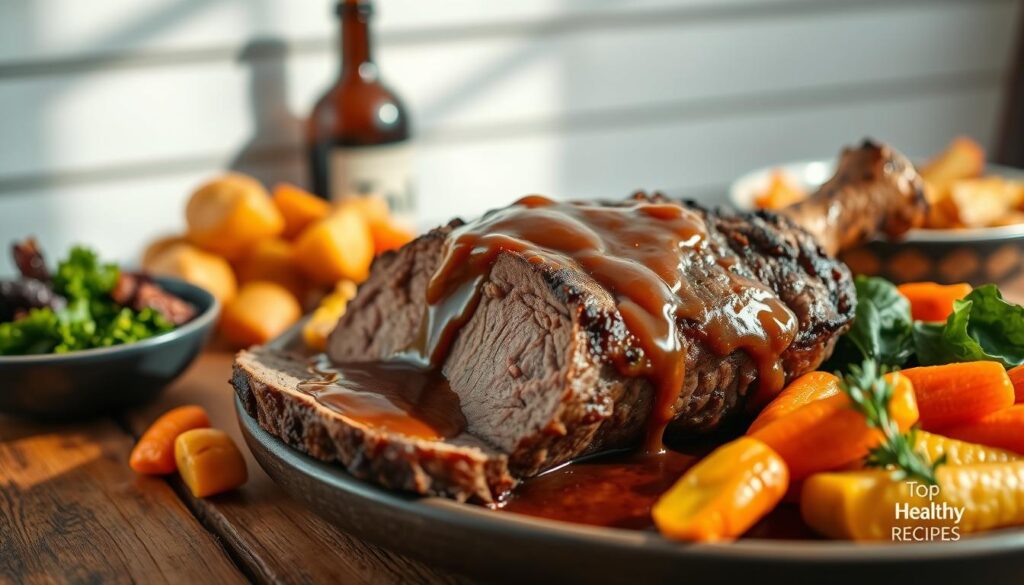
Coulotte Roast can also fit paleo, keto, and dairy-free diets with a few tweaks. For paleo and keto, use approved ingredients and avoid sugars and grains. For dairy-free, swap dairy for non-dairy alternatives in your recipes.
Conclusion: Enjoying Your Beef Coulotte Roast
Now you know about the beef culotte roast. It’s time to enjoy this tender and juicy cut at your table. This cut is a great value compared to more expensive ones with similar qualities.
Key Takeaways
To recap, picking the right coulotte roast means looking for marbling and size. You also have the choice between organic and conventional options. Proper preparation includes marinating, seasoning, and cooking to the right temperature.
Whether you like oven roasting, grilling, or sous vide cooking, a meat thermometer is key. It ensures your coulotte steaks are cooked just right.
Experiment with Flavor
Once you’ve got the basics down, try new seasoning combinations and cooking methods. Find your favorite way to prepare coulotte roast. Pair it with different side dishes and sauces to discover your top choices.
Cooking is both a science and an art. Trust your instincts and enjoy the process. With these tips, you’ll make delicious beef culotte roasts that will wow your loved ones. Start exploring the world of coulotte steaks and enjoy cooking this amazing cut of beef.
FAQ
Is Coulotte Roast Tender?
Can You Cook it in a Slow Cooker?
What is the Price Point of Coulotte Roast Compared to Other Cuts?
Can I Substitute Coulotte Roast if it’s Unavailable?
Is Coulotte Roast Suitable for Special Diets?
What are Coulotte Steaks?
How Does Beef Culotte Differ from Coulotte Roast?
What is a Beef Coulotte?
For more cooking tips, stay connected with us. We also recommend the cookbook Skinnytaste Simple: Easy, Healthy Recipes with 7 Ingredients or Fewer
For more Recipes about Steak ?
Did You try our recipe ?
There are no reviews yet. Be the first one to write one.
